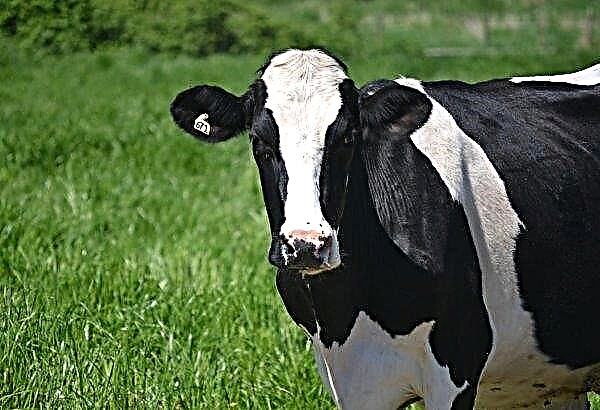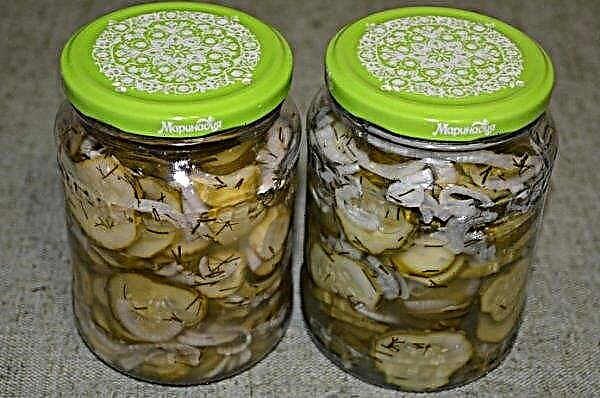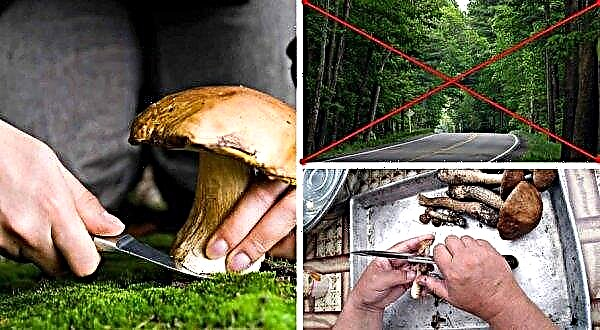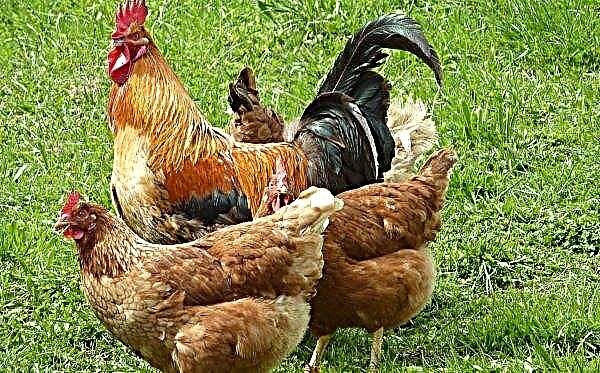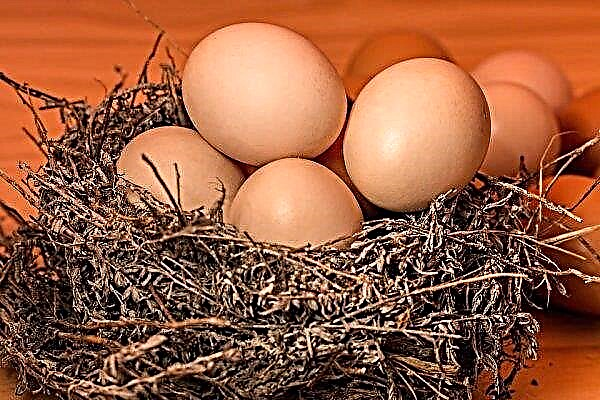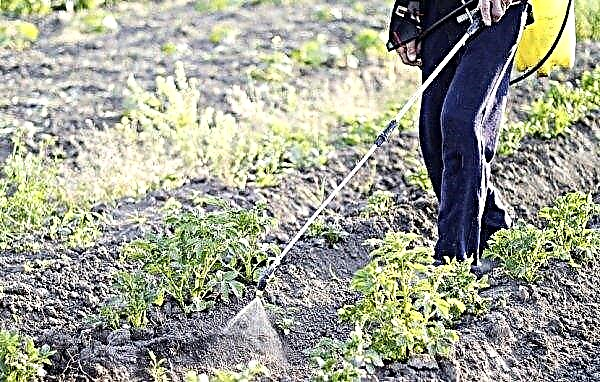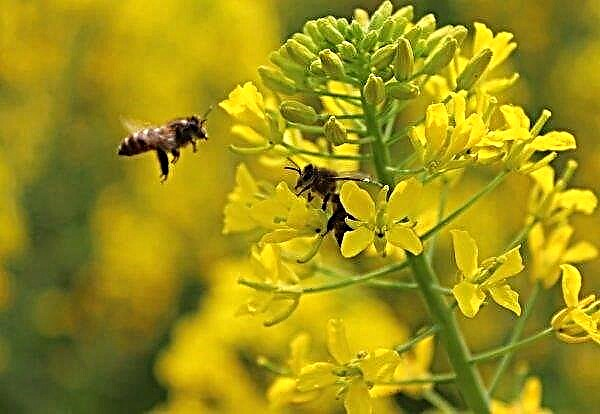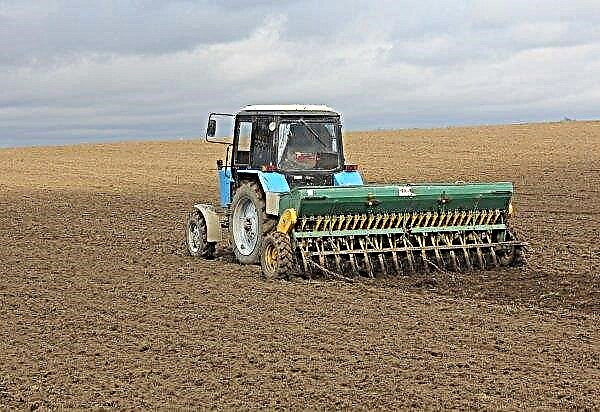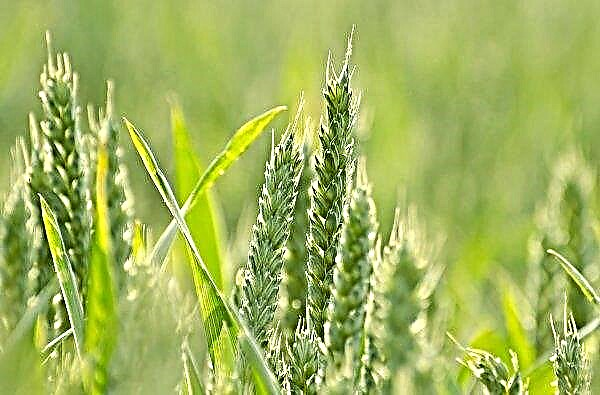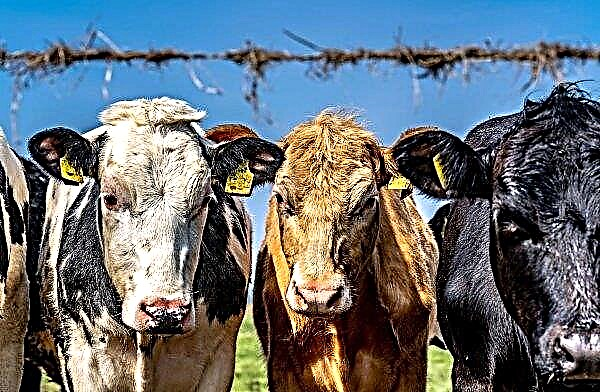New Dutch hybrid variety “Pink Unicum F1” with good yield and excellent fruits will surely appeal to all tomato lovers. Unpretentious and hardy, the variety is recommended for cultivation in greenhouses. About the features of Pink Unicum and the technique of growing it, read this review.
Grade description
The Pink Unicum F1 tomato was bred by the Dutch breeders of Monsanto about 10 years ago. Seeds are supplied by Seminis. The distinctive features of the variety are its unpretentiousness and fruiting along almost the entire height of the bush. The main characteristics of the tomato:
The main characteristics of the tomato:
- the variety is non-determinant, therefore, if you do not pinch the top of the plant, it can grow very high (above 2 m);
- is a hybrid (F1);
- refers to mid-ripening varieties with a ripening period of the crop - 110–115 days;
- It is intended for cultivation in the spring and in the summer in the greenhouse or under a film;
- the formation of a bush can be carried out in 1 stalk or in several;
- the leaves are medium, with shortened distances between them, dark green in color;
- 5–6 brushes of 5–7 fruits are formed on 1 stalk;
- the yield of 1 bush is about 6 kg;
- productivity - 10-17 kg per 1 sq. km. m area;
- fruits - smooth, rounded, uniform, ribbed at the stalk;
- tomatoes are resistant to cracking;
- fruit weight - 200–230 g;
- pulp - sugary, juicy;
- taste is sweetish;
- the variety is resistant to root rot, fusarium, nematodes, tomato mosaic, spotting.
Did you know? The highest tomato reached a height of 19.8 m. This was recorded by the Guinness Book of Records on May 11, 2000. The farm on which the giant bush grew is owned by the UK's Nutritionure Ltd.
Advantages and disadvantages
- Among the main advantages of the Pink Unicum F1 variety are the following:
- like all hybrids, the variety gives amicable shoots and mass ripening of fruits;
- all fruits are approximately the same size;
- fruits are easily transported and stored for a long time;
- the variety is undemanding to growing conditions and can tolerate temperature extremes;
- resistant to most diseases of the nightshade family;
- possesses strong immunity;
- characterized by good productivity;
- Tomatoes have excellent taste.
- The disadvantages of the variety:
- “Pink Unicum F1” refers to hybrid varieties, so the next year you need to buy seeds;
- if you store the fruits until winter, then their taste becomes grassy;
- the variety is unstable to apical rot.
Photo gallery
Self-growing seedlings
Farmers start preparing for the summer at the end of winter or the beginning of spring - when they plant seeds for seedlings. By the time of planting in the soil, the age of seedlings should be 55-60 days.
- strong trunk;
- well developed leaves;
- high level of acclimatization when landing in the ground.
Did you know? Most modern tomato varieties are hybrids. They were created by crossing between two genetically different plants in order to combine the best properties from each.
Pink Unicum F1 seedlings can be grown in a room or in a greenhouse if it is heated. A prerequisite for good seedlings is diving in the phase of the first true leaf. This strengthens the immunity of plants, improves the root system, lays the foundation for stable plant growth and abundant harvest.
Signs of excellent dive seedlings are:
Optimum timing for sowing
Tomato "Pink Unicum F1" refers to early ripening varieties. From the appearance of seedlings to fruiting takes 110-115 days.
You can plant seedlings for a heated greenhouse in late February or early March. The average date for planting seeds is March 10. But the milder the climate in your area, the sooner you can sow.
The soil
The properties of the soil are crucial for the formation of a strong plant and high yields. Tomatoes need soil with a slightly alkaline reaction: with a level of acidity (pH) from 6.2 to 6.8. For heavy clay soils and annually used household plots this indicator is likely to be different. To reduce acidity, the soil is mixed with hydrated lime, dolomite flour or chalk, reducing the level of acidity. You can also improve soil quality with organic fertilizers: peat, compost or manure. The soil for tomatoes must be loose, rich in nutrients.
To improve soil composition, it is recommended:
- digging up the soil both in the plot and in greenhouses - this improves soil aeration;
- make nitrogen-potassium fertilizers to form a good root system.
 To disinfect the soil, it can be treated with boiling water, as well as a 3% solution of potassium permanganate. Boiling water destroys not only pests, but also microorganisms that cause the development of Solanaceae diseases.
To disinfect the soil, it can be treated with boiling water, as well as a 3% solution of potassium permanganate. Boiling water destroys not only pests, but also microorganisms that cause the development of Solanaceae diseases.Capacity for growing
To grow seedlings, you can use the means at hand or containers purchased in the store. It can be:
- plastic and wooden boxes;
- cups of yogurt or sour cream;
- polypropylene cups for drinks;
- special sections for seedlings from a flower shop;
- peat tablets;
- peat cups.
 Peat tablets are considered the most modern means for growing seedlings. They are compressed peat mix in a mesh package. The tablet already has the necessary set of trace elements for good seed development.
Peat tablets are considered the most modern means for growing seedlings. They are compressed peat mix in a mesh package. The tablet already has the necessary set of trace elements for good seed development.Important! The roots should not be crowded in the tank - otherwise, after transplanting, they will begin to actively develop, thereby halting the growth of the bush.
Seed preparation
For germination, you need to take healthy yellow seeds and disinfect with hot water at a temperature of 60 ° C for 15–20 minutes. You can also warm the seeds under a table lamp. The purpose of this operation is to destroy pathogenic microflora.
As for the Dutch seeds, you can be sure that they are already treated for various diseases. Information on this can be found on the packaging. Seeds are also treated with a 3% solution of potassium permanganate (potassium permanganate) for 3-4 hours.
So that the seeds give friendly shoots and actively develop, apply soaking in a growth stimulator. It can be Energen, Zircon or any other drug of the same group. Growth stimulator can improve seed germination, even if the batch was stored under adverse climatic conditions.
Video: Preparing seeds for sowing
Sowing seeds
If there is such an opportunity, then use peat tablets for growing seedlings. Tablets need to be placed in a plastic container and wet; absorbing moisture, they increase 5 times and take the form of cylinders. Each of them contains one seed. The container is covered with a film until emergence. Remember to air the contents of the containers daily for 1 hour.
The seed planting depth is 1 cm. When planting in boxes, the seeds are planted at a distance of 2 x 3 cm. After planting, the soil is sprayed from the spray gun and covered with a film. Shoots should appear on the 7-10th day.Important! Seeds are stored only in a heated room. If tomato seeds were stored at sub-zero temperatures, their germination is reduced by 2 times.

Seedling Care
When 2–3 true leaves are formed, seedlings are dived from boxes into separate containers. If you grew seeds in peat tablets, then you need to plant the plants in large cups together with all the peat when the roots begin to sprout actively.
During the growth of seedlings, plants need to be fed twice. The composition of fertilizing include nitrogen, potassium and phosphorus. Most often, the following list of components is used:
- ammonium nitrate - 5 g;
- superphosphate - 7.5 g;
- potassium chloride - 5 g.
Fertilizers are diluted in 2.5 liters of water and gently watered the mixture with the root zone. The first top dressing is carried out in the development phase of 2-3 true leaves, and the second - 14 days after the first. Before applying fertilizer, the earth should be well watered with a watering can. Do not forget to give the plants enough space for the good development of the bushes. So that the plants do not stretch during growth, they organize uniform illumination of seedlings with fluorescent lamps for 14–18 hours a day. The air temperature in the room is kept at the level of 18–20 ° С. Humidity is at the level of 60–65%.
So that the plants do not stretch during growth, they organize uniform illumination of seedlings with fluorescent lamps for 14–18 hours a day. The air temperature in the room is kept at the level of 18–20 ° С. Humidity is at the level of 60–65%.
Seedling hardening
Plants need not only good watering and lighting, but also hardening procedures. So, in natural conditions, the stem is strengthened when it resists wind gusts. Using a small fan will improve air exchange and harden tomatoes.
At the age of 40–45 days, it is recommended to adapt the seedlings to natural conditions - temper. Tanks with plants are taken out into the fresh air during the day for 1-2 hours daily. Every day, the time spent in the air is increased until it reaches a full daylight hours.
Hardened seedlings acclimatize much better to a permanent place of growth, are less susceptible to disease and form a better crop.Important! It is not recommended to leave tomatoes for a long time in the bright sun or at a temperature below 14 ° C.

Planting seedlings in a permanent place
Planting seedlings in the ground occurs on 55-60 days. Since the Pink Unicum F1 variety is greenhouse, he is not afraid of soil frosts - it’s enough to prepare the soil in the greenhouse and apply all the fertilizing before planting tomatoes. If you decide to improve the condition of the soil with organic fertilizers, you need to apply them a week before transplanting seedlings in order to improve the absorption of nutrients. In dry form, fertilizers are applied to the place of direct planting of plants - in holes or trenches, mixing fertilizer and soil to a depth of 10 cm.
For planting, healthy tomatoes with a developed stem and a powerful root system are selected. The height of the plants should be about 30 cm. Age - 55-60 days. The bush should have 8-10 true leaves. If an ovary has formed on the plant, it is removed to direct efforts to rooting. Landing is carried out in rows. The distance between the individual bushes should not be less than 0.6 m. When planting, plants are carefully removed along with the soil from the cups and set in the wells. If the trunk is slightly extended, it can be laid in a trench - this will reduce the size of the bush and a stronger root system will be formed. Plants should be planted in the evening. Air temperature should not be lower than 15–20 ° С.
When planting, plants are carefully removed along with the soil from the cups and set in the wells. If the trunk is slightly extended, it can be laid in a trench - this will reduce the size of the bush and a stronger root system will be formed. Plants should be planted in the evening. Air temperature should not be lower than 15–20 ° С.
Outdoor Care
The main activities for the care of tomatoes in the ground:
- regular weekly watering;
- fertilizing with fertilizers 1 time in 2 weeks;
- climate control and corrections;
- maintaining the shape of the bush: garter, pinching;
- prevention and control of diseases and pests.
Watering
For the good development of seedlings, the soil must contain a sufficient amount of moisture, so watering is carried out weekly. The rate of watering for 1 adult bush is 12 liters of water per week. In modern vegetable growing, drip irrigation is applied with the introduction of moisture directly into the soil under a small pressure - this way the plants are not stressed due to cold water or droplets falling on the leaves. Excess moisture can attract pests.
Fertilizer application
Top dressing is usually carried out at least 3. The first - 2 weeks after planting in a permanent place, the second - no less than 15 days in the budding phase, and the third - after another 2 weeks. The main fertilizers: nitrogen, potassium, phosphorus. They can be part of a complex mixture or used with individual fertilizers.
Fertilizers of organic origin containing the above substances can be used, or synthetic industrial preparations can be purchased at the store. The list of typical synthetic fertilizers includes:
- ammonium nitrate;
- superphosphate;
- potassium sulfate.
 In order to correctly calculate the amount of fertilizer needed, it is important to know what and how much is in the greenhouse soil. If it is not possible to establish the exact composition, pay attention to indirect signs of an excess or deficiency of trace elements in plants. If you are not sure, start with a half dose of the amount indicated on the fertilizer packaging.
In order to correctly calculate the amount of fertilizer needed, it is important to know what and how much is in the greenhouse soil. If it is not possible to establish the exact composition, pay attention to indirect signs of an excess or deficiency of trace elements in plants. If you are not sure, start with a half dose of the amount indicated on the fertilizer packaging.
Did you know? The first documented evidence of organic fertilizer use dates back to ancient Japan. There plants fertilized with feces. At the same time, the dung of the rich was considered more useful, since they ate better, which means they produced a better product.
Stepson
Stitching is the process of removing side shoots. The main goal is to direct nutrients to bear fruit. If this is not done, then the bush will form many leaves, but there will be very few fruits. Lateral shoots appear in the axils of the main stem; they must be pinched off at a height of 0.5 cm. The Pink Unicum F1 variety belongs to non-determinant varieties and theoretically can grow to any height. Even the height declared by the manufacturer of 1.5 m may not be very convenient. If you want to stop the growth of the bush - just pinch its top. Do not forget to remove the lower leaves as the bush grows, as they can facilitate access for infection to various fungi.
The Pink Unicum F1 variety belongs to non-determinant varieties and theoretically can grow to any height. Even the height declared by the manufacturer of 1.5 m may not be very convenient. If you want to stop the growth of the bush - just pinch its top. Do not forget to remove the lower leaves as the bush grows, as they can facilitate access for infection to various fungi.
Soil care
Among the main soil care activities are:
- weed weeding;
- aeration (loosening);
- mulching;
- hilling.
 The tasks of loosening include:
The tasks of loosening include:- improved root oxygen supply;
- weed control;
- pest control.
Mulching is necessary in order to preserve soil moisture after irrigation, to prevent the growth of weeds and to protect the root system from pests. Mulch is organic and inorganic. Organic include leaves, sawdust, grass; to inorganic - agrofibre, spunbond, cardboard and others. Lay the mulch around the plant so as to be able to water the plants.Did you know? There are wild varieties of tomatoes, also belonging to the genus Solanum. Their fruits are smaller; some of them are poisonous. If you come across a wild variety of tomatoes - do not eat it if you are not sure of its edibility.
Tying bushes
Just as people need a skeleton for upright posture, tomatoes need support to maintain their vertical shape, maintain the weight of ripening fruits and prevent diseases associated with excess moisture. Tall Pink Unicum F1 tomatoes in a greenhouse can be tied to a vertical trellis.
As the plants grow, they simply pull it up to the ceiling of the greenhouse. The vertical trellis is a cord fixed in the upper part of the greenhouse. Consider also that the yield of a variety in a greenhouse is higher than if it were grown in open ground - therefore, the cord should be convenient enough to hold up to 9 kg of fruit weight. Garter makes it easier to care for plants: they are easier to water, fertilize, hilling and perform other agricultural procedures.
Consider also that the yield of a variety in a greenhouse is higher than if it were grown in open ground - therefore, the cord should be convenient enough to hold up to 9 kg of fruit weight. Garter makes it easier to care for plants: they are easier to water, fertilize, hilling and perform other agricultural procedures.
Harvesting
Harvesting hybrid varieties is characterized by almost simultaneous ripening. In ripe form, Pink Unicum F1 tomatoes are represented by bright pink rounded fruits, slightly ribbed at the stem, weighing 200–230 g. The color of the fruit is uniform. Ripening time - June, August (115 days after emergence). The fruits are torn off with the removal of the stalk and placed in boxes. You can put in a box up to 3 layers of tomatoes, shifting layers of paper.
Tomatoes should be stored in a dry, well-ventilated area at temperatures above 5 ° C.Important! Tomatoes continue to grow even after they are collected and stacked in boxes. Therefore, they can not be stacked too tightly.
Care for tomatoes of the Pink Unicum F1 variety is quite simple - plants do not require special knowledge or high costs to obtain an excellent crop. Compliance with the timing of all agricultural work will allow you to get the maximum yield on your site.


